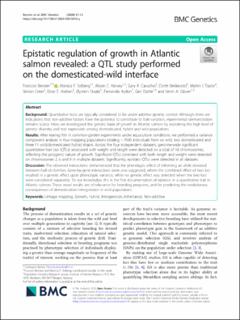| dc.contributor.author | Besnier, Francois | |
| dc.contributor.author | Solberg, Monica Favnebøe | |
| dc.contributor.author | Harvey, Alison C. | |
| dc.contributor.author | Carvalho, Gary R. | |
| dc.contributor.author | Bekkevold, Dorte | |
| dc.contributor.author | Taylor, Martin I. | |
| dc.contributor.author | Creer, Simon | |
| dc.contributor.author | Nielsen, Einar Eg | |
| dc.contributor.author | Skaala, Øystein | |
| dc.contributor.author | Ayllon, Fernando | |
| dc.contributor.author | Dahle, Geir | |
| dc.contributor.author | Glover, Kevin | |
| dc.date.accessioned | 2020-10-16T11:39:49Z | |
| dc.date.available | 2020-10-16T11:39:49Z | |
| dc.date.created | 2020-05-20T14:49:05Z | |
| dc.date.issued | 2020 | |
| dc.identifier.citation | BMC Genetics. 2020, 21 (1), . | en_US |
| dc.identifier.issn | 1471-2156 | |
| dc.identifier.uri | https://hdl.handle.net/11250/2683336 | |
| dc.description.abstract | Quantitative traits are typically considered to be under additive genetic control. Although there are indications that non-additive factors have the potential to contribute to trait variation, experimental demonstration remains scarce. Here, we investigated the genetic basis of growth in Atlantic salmon by exploiting the high level of genetic diversity and trait expression among domesticated, hybrid and wild populations. | en_US |
| dc.language.iso | eng | en_US |
| dc.title | Epistatic regulation of growth in Atlantic salmon revealed: a QTL study performed on the domesticated-wild interface | en_US |
| dc.type | Peer reviewed | en_US |
| dc.type | Journal article | en_US |
| dc.description.version | publishedVersion | en_US |
| dc.source.pagenumber | 17 | en_US |
| dc.source.volume | 21 | en_US |
| dc.source.journal | BMC Genetics | en_US |
| dc.source.issue | 1 | en_US |
| dc.identifier.doi | 10.1186/s12863-020-0816-y | |
| dc.identifier.cristin | 1811955 | |
| dc.relation.project | Norges forskningsråd: 200510 | en_US |
| dc.relation.project | Norges forskningsråd: 216105 | en_US |
| dc.relation.project | EC/FP7/311920 | en_US |
| cristin.ispublished | true | |
| cristin.fulltext | original | |
| cristin.qualitycode | 1 | |
